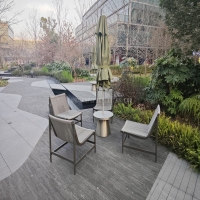Welcome to the website for landscape facilities products and knowledge.
How does the table’s shape influence the distribution of weight and pressure across its surface?
The geometry of a table fundamentally dictates how weight and pressure are distributed across its surface and through its supporting structure. This principle, governed by physics and engineering mechanics, reveals why different table shapes perform uniquely under load.
Circular tables exhibit exceptional pressure distribution characteristics. Weight applied anywhere on the surface radiates symmetrically toward the perimeter, typically supported by a central pedestal or multiple legs at the circumference. This radial distribution creates relatively even pressure across the entire surface, with minimal concentration points. The circular form efficiently channels forces toward the center and outward edges simultaneously, making these tables remarkably stable, especially when loads are placed near the edges.
Rectangular and square tables demonstrate completely different mechanical behavior. Their planar geometry creates distinct load paths along parallel and perpendicular axes. Weight distribution follows predictable linear patterns toward the supporting legs at each corner. This results in significant pressure concentration directly above the leg positions, while the center of longer spans experiences reduced support. The aspect ratio—the relationship between length and width—critically influences this dynamic; longer tables develop greater bending moments at the center, potentially creating pressure voids in mid-span areas.
Oval tables combine attributes of both circular and rectangular designs. They maintain the continuous support characteristic of circular tables while offering the elongated form of rectangular ones. Pressure distributes more evenly than in rectangular tables of similar length, though some concentration occurs at the curved ends. The smooth curvature prevents the sharp pressure points found at rectangular corners.
The number and placement of supporting legs directly interact with table shape to determine pressure patterns. A four-leg rectangular table creates four distinct high-pressure zones, while a trestle-supported rectangular table generates two linear high-pressure regions along the support beams. Central pedestal supports, common in round tables, create a single central pressure point where the pedestal connects, with diminishing pressure toward the edges.
Material properties further modify these geometric effects. Rigid materials like solid wood maintain the theoretical pressure distribution more accurately, while flexible materials may redistribute pressure through deflection. The table thickness and internal bracing also significantly influence how the inherent shape-based distribution manifests in practice.
Understanding these principles allows for better furniture selection based on intended use. Heavy objects benefit from the even distribution of circular tables or the supported centers of well-braced rectangular designs. The engineering behind table shape ultimately determines not just aesthetics but functional performance, structural integrity, and safety characteristics across diverse applications from dining to industrial workstations.
Related search:

Recommendation
Metal structure rattan chair without armrests for single person, with woven seat and backrest.